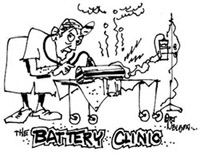Lead Acid (Gel Cell) charging
Lead acid (gel cells) should be charged with a constant potential charger specifically
designed for these batteries. These are sometimes referred to as a CVC charger. You can charge them with
a constant current charger but you must terminate charge when the voltage reaches 14.7 volts. You should not exceed the C/10
charge rate. If you have a 7 Ah battery in your field box the maximum constant current charge rate should not exceed 700 mA.
It will take about 14 hours to charge from a fully discharged state (voltage less than 12 volts).
A CVC (Constant Voltage Charger) is exactly what
the name implies. It is clamped at a certain voltage and puts out all the current it can until the battery reaches the clamp
voltage, usually something around 14.5 volts, then the current drops off to maintain it at this voltage. A constant voltage
charger is characterized as one having a current capability of supplying a fixed voltage to whatever load is applied. A constant
current charge on the other hand will provide whatever voltage is necessary to force a fixed
value of current though a load. Constant current charges have a much higher internal resistance
than the load so that any variation on the load will not change the current being supplied. Constant voltage charges have
a very low resistance as compared to the load and will supply whatever current necessary to maintain a given voltage at the
load.
Many inexpensive chargers used for sealed lead batteries
are what is called taper chargers, these are set up so the voltage tapers off as the full charge voltage
is reached. True constant potential (CVC) chargers can be quite expensive so a compromise is made in the design to control
costs.
We have used the term sealed lead battery
in this discussion. These batteries are not truly sealed as cylindrical Ni-Cds are. They have a gelled electrolyte system
where there is a modest recombination of the oxygen in overcharge in some designs. All require venting of the oxygen and hydrogen
byproducts of charging and discharging. This is why you should never totally seal these in a field box where these gasses
can accumulate. Mixtures of oxygen and hydrogen can cause spectacular "events" if a spark is provided (from an electric
fuel pump motor).
How much charge is
there in the battery?
Unlike Ni-Cds you can read the
remaining capacity quite easily with a voltmeter.
After the
battery has been on rest for a few hours read the voltage (no load). 12.0 volts is essentially fully discharged while 13.0
is fully charged. This is a fairly linear relationship so a reading of 12.4 volts means you have 40% of the capacity remaining.
Never leave a lead acid battery in the discharged condition.
The lead acid battery should never be left to set in the discharged
condition or sulfation will result. The sulfuric acid in the electrolyte reacts with the sponge lead active material and forms
lead sulfate. It is a poor conductor. This coupled with the H2O left after you take all the S out of H2SO4 is also a poor
conductor so trying to charge requires a lot of voltage to push the current through required to convert the active material
back to the charged state. Sometimes they just cannot be brought back from the sulfated state.
The good news is that sealed lead batteries retain their charge much longer than Ni-Cd, At room
temperature it's well over a year. So all you have to do is make an occasional open circuit voltage check to see if you
need to charge it.
For a great deal of information on Flooded
Lead Acid (Automotive and Deep Cycle) go to:
Automotive & Deep Discharge Information
This material is oversimplified I know, but more detailed explanations
can be had at my commercial rate of $125/hr plus expenses.

